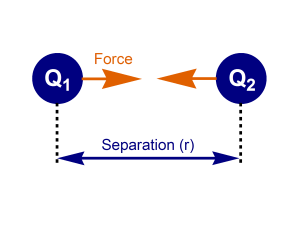Write out all the givens for this problem.
#"Given"#
#q_(1) = 3.00xx10^(−6)C#
#q_(2) = -1.50xx10^(-6)C#
#r = 12.0" cm"or(0.12" m")#
To calculate the Coulombic Force between 2 point charges, you use the following:
#color(white)(aaaaaaaaaaaaaaaa)color(magenta)(F_(c) = (k |q_(1)|q_(2)|)/r^2#
#color(white)(aaaaaaaaaaaaa)##"Since we are only looking for the"#
#color(white)(aaaaaaaaaaaaa)##"magnitude of the force, we use"#
#color(white)(aaaaaaaaaaaaa)##"the absolute values of each point"#
#color(white)(aaaaaaaaaaaaa)##"charge, so the signs are ignored"#
Where
#k = "Coulomb's constant" (9xx10^9" (N*m^2)/(C^2))#
#---------------------#
Plugin
#color(magenta)(F_(c) = (k |q_(1)|q_(2)|)/r^2#
#F_(c) = [(9*10^9" (N*cancelm^2)/(cancel(C^2))) * (3.00*10^(−6)cancelC)*(1.50*10^(-6)cancelC)]/(0.12cancelm)^2#
#color(blue)(|F_(c)|= 2.813" N"#
Note: If we included the signs in the formula, a (-) force would indicate attraction between the two charges and a (+) force would indicate a repulsion.
#color(white)(aaa)#
The force on #q_(1)# due to #q_(2)# is #2.813" N"# and the force on #q_(2)# due to #q_(1)# is also #2.813" N"#. Magnitude of the force is the same but the direction is opposite.
#color(white)(aaaaaaaaa)#


